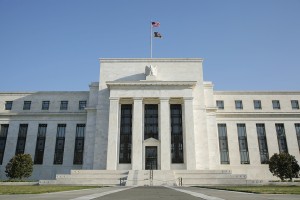Last month, the Federal Reserve further reduced its third round of quantitative easing (QE) during its road to tapering. However, the central bank will maintain current Fed Funds Rate of near 0.000 percent – Fed Chair Janet Yellen has already confirmed that she does not have any immediate plans to raise rates.
With the Fed on its way to possibly ending QE, one central bank official believes low inflation levels could very well cause the Federal Open Market Committee (FOMC) to delay the taper talk, but he doesn’t think it’ll happen.
Speaking in an interview with Bloomberg Radio late last week, Federal Reserve Bank of St. Louis President James Bullard explained that slow rates of inflation could suspend the tapering of monthly bond-buying purchases and apply pressure on the monetary policymakers.

According to official Fed numbers, the annual inflation rate has slowed down to 0.9 percent in February from 1.2 percent in the month prior. It has remained under the two percent threshold mandated by the Fed for the past two years. He expects the number to increase as the United States economy improves, the European situation stabilizes and inflation remains steady.
Yellen told reporters that the economy continues to remain weak and that stimulus is still needed.
“I think this extraordinary commitment is still needed and will be for some time, and I believe that view is widely held by my fellow policymakers at the Fed,” Yellen said in her first major speech late last month.
It was reported that the European Central Bank (ECB) is on the verge of applying quantitative easing measures, but ECB head Mario Draghi is hesitant, despite urgent calls from eurozone leaders and the International Monetary Fund (IMF).
Speaking at last week’s ECB governing council meeting, Draghi stated:
“The governing council is unanimous in its commitment to using also unconventional instruments within its mandate in order to cope effectively with risks of a too prolonged period of low inflation.”
Is inflation really at less than one percent in the U.S.? According to alternate inflation charts produced by Shadow Stats, a website that calculates “inflation for today as if it were calculated the same way it was in 1990,” consumer inflation is actually at close to six percent, while the M1, M2 and M3 money supplies are hanging between five and 11 percent.
Others aren’t so sure that the Fed is giving the real numbers because “a tsunami of inflation” could very well hit the U.S. soon.
“We’re going to be hit with a tsunami of inflation,” said Peter Schiff, President of Euro Pacific Capital, in an interview with USA Watchdog. “I think we’re going to be stuck with a lot of the money, which means it will bid up consumer prices. New Fed Chief Janet Yellen said she wants more inflation. Well, she’s going to get it.”
Indeed, a little bit of research on any search engine will highlight the growing effects of inflation on the wallets of millions of Americans.
Economic Policy Journal has also listed the numerous inflation levels that are transpiring in the U.S. economy, particularly in the fields of real estate, food, art, telecommunications and others, with its “There Is No Inflation Report.”




